The global food system is a violent mess. It is rooted in neocolonialism, manufactured scarcity, and mass alienation. The enclosure of farms and subsistence forms of life has destroyed social and collective knowledges of how to produce and share food. It’s no accident that attempts to create food autonomy and collectivize its production and distribution, even on a local scale, have been met with state violence—ask any Food Not Bombs chapter. For this issue of e-flux journal on agriculture and the social bonds inherent to food, we have invited autonomous collectives, farmers, and artists to talk about their projects in short communiques from the garden, forest, or pasture. Spread over much of Turtle Island, they offer tactics to uproot capital and share stories about the lands they inhabit.
—Editors
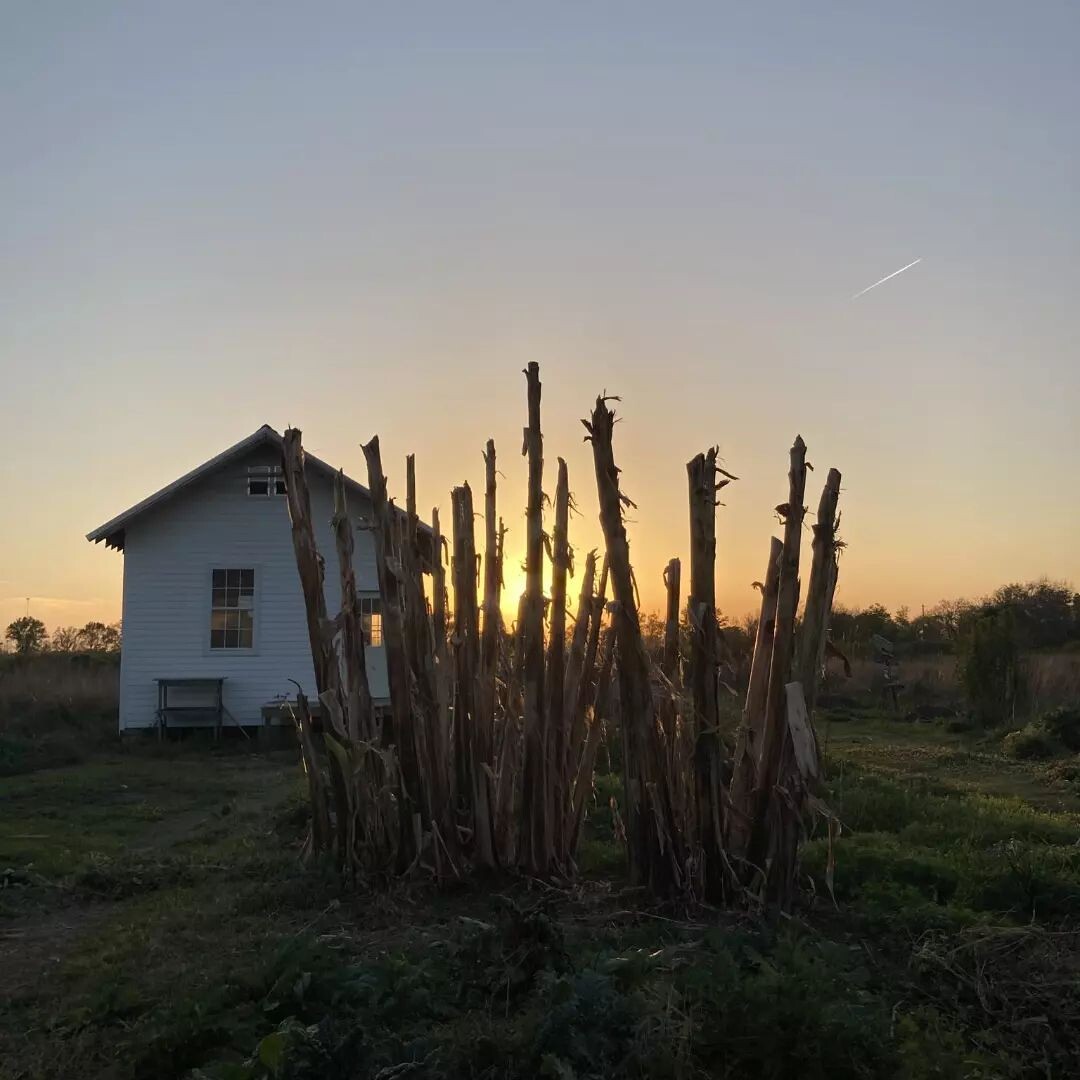

Bananas at sunset, March 2022. Photo uploaded to Ndn Bayou Food Forest’s Instagram on April 2, 2022.
Communique From a Participant Defending the Atlanta Forest
I lean against a tall tree while an Atlanta Police Department helicopter thunders overhead, fifty feet above me just beyond the canopy. The people in the chopper believe that this forest will be razed and turned into the largest police training campus in the country, including munitions and firearms ranges, a mock city for urban combat drills, and the largest soundstage complex on earth (in partnership with Blackhall Studios). The latter, they think, will be used to produce Hollywood movies and virtual reality. I instead believe that the forest will remain a forest. We are at war.1
As much as the forest needs us at this moment, we also need the forest. As climate change has already brought unprecedented heat and flooding to south Atlanta, we remember that the forest cools the air, shades the soil, and absorbs storm water. As famine spreads because the capitalist food system crashes against limits imposed by its own destruction of the earth, we are reminded that the South River Forest is already a food forest with many wild fruit trees and other edible plants.
We who defend and inhabit this forest have also begun planting crops and fruit trees in natural clearings and sowing edible native wildflowers in the paths of destruction left by Blackhall Studios bulldozers. By the time the Cop City project is eventually defeated, and the police are humiliated and driven from this forest, we will have already begun gently transforming it into a zone of communal food production: grafting cider apples onto Bradford pears; clearing privet and scrub with goat herding; reducing insect density with chickens, guineas, and ducks; thinning young oaks, hackberry, and maple to inspire mushroom production; planting sunchokes, sochan, nettles, cowpeas, sweet potatoes, squash, beans, okra, as well as chestnut, persimmon, pawpaw, serviceberry, mulberry, and fig trees. This is not only to feed ourselves, but also to produce a positive, material, place-based culture. This is our alternative to the destruction promised by a future ruled by cops and virtual reality.
Hiding beneath the old tree, I can clearly make out a figure inside the helicopter. I remind myself that there’s almost no way he could have seen me. In this way and others, the forest protects us. The visibility from police helicopters and drones is rendered mostly useless by the canopy, driven up by a lifelong growth towards the sun. I take the opportunity to graze on a patch of tiny wild strawberries; they are smaller than peas and not very sweet, but my water bottle is empty, and their juice is refreshing. Before long the chopper veers off.
Strange moments like these are common here. The slow time of the forest breaks through the fast time of crisis, and two different worlds slide past each other. In one, my fast-beating heart. In the other, the calm and patient vastness of a centuries-old water oak. In one such moment together, while on our way to gather old truck tires for a barricade, we stop under a mulberry tree. “These are going to get me in trouble one of these days, running from the cops and I’m here stopping to snack,” says one friend, recognizing the danger inherent in getting stuck in one temporality while your enemy is operating in another.
The police are not immune to this danger either: caught in the bureaucratic time of work weeks and fiscal years, the entire Cop City project can be understood as a knee-jerk reaction to conditions imposed by the George Floyd Rebellion, particularly the police’s loss of legitimacy. They are even having trouble hiring new officers. Meanwhile, they are oblivious to the deep time of this forest, to all the many relationships that have developed between the forest and the people who use it.2 They are unaware of the weight of all the harm done by them and their predecessors, the slow accretion of centuries of rage, fear, and despair into sediment, strata, and eventually tectonic plates grinding against each other, their movement slow and gradual until it isn’t.
This ignorance is nowhere more apparent than their plan to destroy and build over the ruins of the old Atlanta City Prison Farm, a prison where incarcerated people were forced to live and work to produce food for Atlanta’s carceral system from 1920 to 1989. It’s unlikely that this is a conscious attempt by the police to erase the history of their own crimes.3 They have already absolved and forgiven themselves. Indeed, rather than distancing themselves from the legacy of the prison farm, the Atlanta Police Foundation seems to have been inspired by it, including “urban gardens” in their design, where inmates from At Promise Youth Centers (police-run reeducation camps for unruly children) would work as part of court-ordered diversion programs. In short, prison slavery made green. Meanwhile, the plans place new explosives and firearms shooting ranges alongside the existing child jail and adult correctional center on the southern edge of the forest, so that the people who are held there would be forced to listen to the police training to kill.
Looking at the plans for Cop City, it is abundantly clear that the police do not see the 2020 uprising as finished. They have not recovered from that moment. It continues to haunt their dreams and they fear its return. They do not feel that their control is guaranteed. Despite this, they also continue to misunderstand the opposition to them, so that even a project dreamed up to bolster their morale and polish their image has been viewed by most people as a new nightmare, and as a result has inspired yet another burning barricade in their path.
Ndn Bayou Food Forest, Louisiana
From Here the Forest Can Only Grow
On its best days, Ndn Bayou Food Forest in South Louisiana is an attack on the petro-industrial agricultural system that surrounds it. It began as a resistance camp against the Bayou Bridge Pipeline four years ago. Today it is a free nursery for the propagation of fruit trees and perennial food crops, and an ongoing experiment in assisted plant migration and the creation of food commons. It is a lush, vibrant alternative to the lifeless factory wastelands of ethanol sugarcane and commercial rice production.
Here on the US Gulf Coast, we prepare not just for rising seas, stronger storms, and saltwater intrusion, but also increased rainfall and temperatures, and at some point, full subtropicalization.
In this catastrophic era, the concept of “invasive species” dissolves into irrelevancy, perhaps to be replaced by that of “refugee species.” At least half of the world’s ecosystems are predicted to entirely shift in type by the end of the century—forests becoming grasslands, grasslands becoming deserts, and so on. Without human intervention to assist plant migration, these changes can only tend toward extinction, desertification, and the decimation of biodiversity. To fight against this future requires rejecting old frameworks of native and nonnative plants, instead orienting ourselves toward solidarity with both endemic and migratory species as they adapt their own survival strategies in the face of catastrophe and change.
It is critical to note that while biomes are largely determined by climactic factors like rainfall and temperature, living ecosystems impact both. It is well known that the high rainfall in the Amazon Basin is due to the exhalations of the rainforest itself. In other words, the difference between a desert and a rainforest can come down to nothing more than the trees and their natural activity. We will decide, to some extent, whether we, wherever “we” are, will live in a desert or a garden world.
At a time when coastal cities like New Orleans, Miami, and Houston live on borrowed time, as we drive past flat depopulated expanses of monoculture sugarcane production and hurricane-destroyed homes that were never rebuilt, we at Ndn Bayou Food Forest try to imagine bountiful jungle orchard gardens, densely inhabited and vibrant with temporary and mobile homes, the sounds of laughter and music spilling from the canopy.
We know that the process of planting the forest is also the process of becoming the people who live in the forest. So, at this moment when so many cannot even imagine a different food system, let alone a different way of relating to the earth, we are busy propagating fruit trees: figs, mulberries, feijoa, avocado, papaya, loquat, chestnut, citrus, moringa, pecan, and banana.
Banana plants, for example, are an ideal ambassador for the coming subtropical forest. They grow fast, making shade for humans and habitats for frogs and lizards. Many varieties thrive in warmer temperate regions but simply don’t fruit because they freeze to the ground each winter. Increasingly popular as ornamentals, their eventual fruiting in the hills of Georgia or the Piney Woods of East Texas and Louisiana will bear undeniable truths about climate change.
Now in its fourth year of cultivation, Ndn Bayou Food Forest is home to figs, mulberries, bananas, citrus, cold-hardy avocados, moringa, feijoa, loquat, pecan, mayhaw, sweet potato, sunchoke, prickly pear, ginger, turmeric, papaya, amaranth, okra, celosia, squash, watermelon, bitter melon, beans, collards, basil, turnips, catfish, and an increasing numbers of birds, lizards, frogs, snakes, toads, turtles, salamanders, rabbits, mice, rats, and really big spiders. The devastation brought by Hurricanes Laura, Delta, and Ida made it clear that the food forest’s only long-term strategy for survival is to grow, and so propagation continues to be the focus. By the time these trees are swept away by a storm or the rising sea, thousands of their scions will be growing across the region, part of a vast and powerful forest.
—Hadley Cels, for Ndn Bayou Food Forest
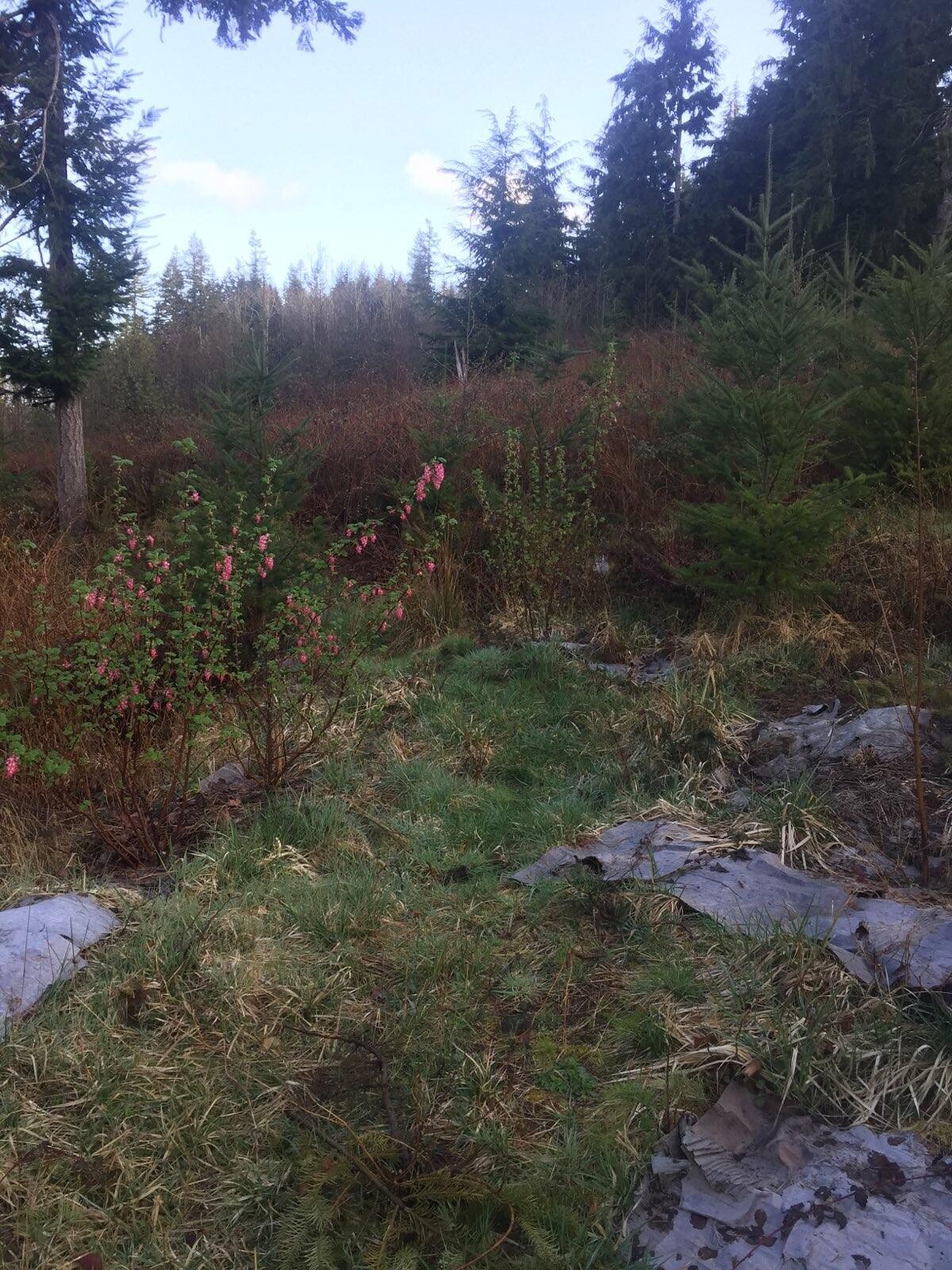

Red flowering currant is a fast-growing native shrub. Interplanted between larger fruit trees, it provides pollinator habitat, chop-and-drop mulch for improving the soil, edible berries, and beautiful early spring flowers.
Anonymous Gardeners in the Olympic Mountains
We live on Twana and S’Klallam land in the foothills of the Olympic Mountains. This ecosystem—once a dynamic forest tended to by people, elk, bears, eagles, beavers, and salmon—is now a patchwork of tree plantations, off-grid homes, and clearcuts (results of logging practices in which all trees in an area are uniformly cut down). A century of white settlement, logging, and cattle grazing on the land we now tend has resulted in a wetland dominated by invasive grasses, stands of second-growth conifers, and a west-facing slope clearcut in 2014. Above us lies a commercial tree plantation owned by Rayonier, a timber company which exploits 2.7 million acres. We purchased this parcel three years ago, as a collective seeking to put our lives further in common.
Gardening here is an experience of contradictory timescales. On the one hand, the disintegration of the American empire, strained food systems, and accelerating climate change create a visceral urgency to grow food and unlearn dependencies on ecological and cultural devastation. On the other hand, we are engaged in a long, slow project of gardening this place. It takes time to know the soil, to orient toward the long-term viability of plant, nonhuman animal, fungal, microbial, mineral, and human life. We could grow more food, faster, if we indiscriminately cleared and tilled the land. Instead, we are urgently insisting on our relational techniques: facilitating decay, storing rain, plucking slugs off cotyledons. We strive not to force the land to be what it isn’t. We are urgently trying to feed future people, cultivating what we call, citing James C. Scott, “fugitive biodiversity.”
Our efforts take place in a sloping clearcut—the sunniest spot on the land, damaged by logging. As beneficiaries of extractive colonialism, the least we can do is attempt repair. Slopes are difficult to farm; standard practices lead to rapid topsoil loss, erosion, and water runoff. Our guiding principles are to instead build soil and retain water. Growing food is secondary, in the short-term sense, but primary in the longer; this land will not sustain vegetal life in a hotter future without tending the soil in the present.
We clear terraces on contour, planting them with trees and shrubs that build soil, retain moisture, and add leaf-litter and shade. By hand-clearing, we can remove invasive blackberries, but preserve the still-present native plants. The red huckleberry, mahonia, and nettles that grow here are as much a part of our present and future food system as the apples, hazelnuts, and serviceberries that we introduce. Terracing with our footsteps reminds us that the trees are terracing with their roots, shifting our ontology of land. Being in good relation to this place requires observation and commitment. This spot, where stumps left by logging have slowly decomposed, is rich and moist with humus; this other spot, compacted by logging trucks, is anaerobic clay.
Growing food in this way is aspirational and experimental. Ironically, the slowness of our future subsistence tethers us more to the present capitalist food system. We feel the pinch of inflation as we are forced to purchase what we cannot produce, while our earliest crops won’t bear for years. It is disorienting and contradictory—as with being white settlers opposed to white supremacy and settler-colonialism while owning stolen land. Perhaps our best intentions of undoing the culture we live in will wither through the contradictions of ownership; perhaps the hazelnut trees will die, or the winters will be too warm for the apples to fruit. In our best dreams this land becomes a vibrant food forest, its bounty accessible through knowledge, entanglement, and responsibility, unmarketable but nourishing, rooted in sharing. If we fail, we hope that our trees, the soil sponge and leaf litter, the flowering currant and the huckleberries, will contribute their nutrients, their energy, and their slow decay to the ongoing subsistence and metabolism of this place.
Upstate New York
An existence based on the earth feels almost impossible in this estranged world. A handful of corporations own the genes, while the supply chain supermarket extravaganza determines what we eat. Agriculture, treated like any other industry, becomes exploitative and demeaning; those who sustain the world are made disposable and invisible. The ability to own or access land—hence, to have the ability to grow food—is too costly or time-consuming for most to consider. Modern infrastructure devastates the topsoil, pollutes the oceans, and fills the atmosphere with carbon dioxide. We’ve known for at least half a century that this paves the way to extinction—of the beings around us and, in all probability, of our species. To ward off the very future those in power make real, they dream up useless technologies and sell us an endless green revolution: DRM tractors, GPS-guided drones, vertical megafarms, doomsday seed vaults, microgreens grown in space.
Food has always been more than matter. It draws us down to earth. Seeds are surrounded by stories and songs, rhythms and traditions, wisdom and gifts. Lifeways turn subsistence into sustenance, survival into nourishment. All around us, we see people grasping the chaotic danger of our times, situated halfway between apocalypse and revolution. Climate strikers cut school. Old heads from Occupy (like ourselves) leave the city behind and head to the farm. Rural folk form co-ops to meet, organize, and share with their neighbors. While the existing system skews the climate to new extremes, a new culture emerges to tip the scales against that system. From the occupied squares ten years ago to today’s land defense projects, a new sensibility is forming, not quite “back to the land,” but rather a return to the earth.
The fresh hands digging into newly planted backyard gardens, permaculture design, and collective land projects testify: we don’t want to live like this anymore. After centuries of dispossession, it’s true that most of us are without experience or tradition. Our efforts can be awkward, full of complicities and complexities, grappling with the unredeemed paradox of living on land that is not ours but that we do inhabit. Whatever the insufficiency of the attempt, we wager it’s outweighed by the chance to reach into the world—not the metaverse, but the real world. We offer no solutions, only a home within the questions. By learning the song of the land, we may just outlast a civilization determined to take us down with it. In abandoning the universal, we may find the ground waiting beneath our feet. Seeking the guidance of the world around us, we might allow ourselves a small beginning in new worlds to come.
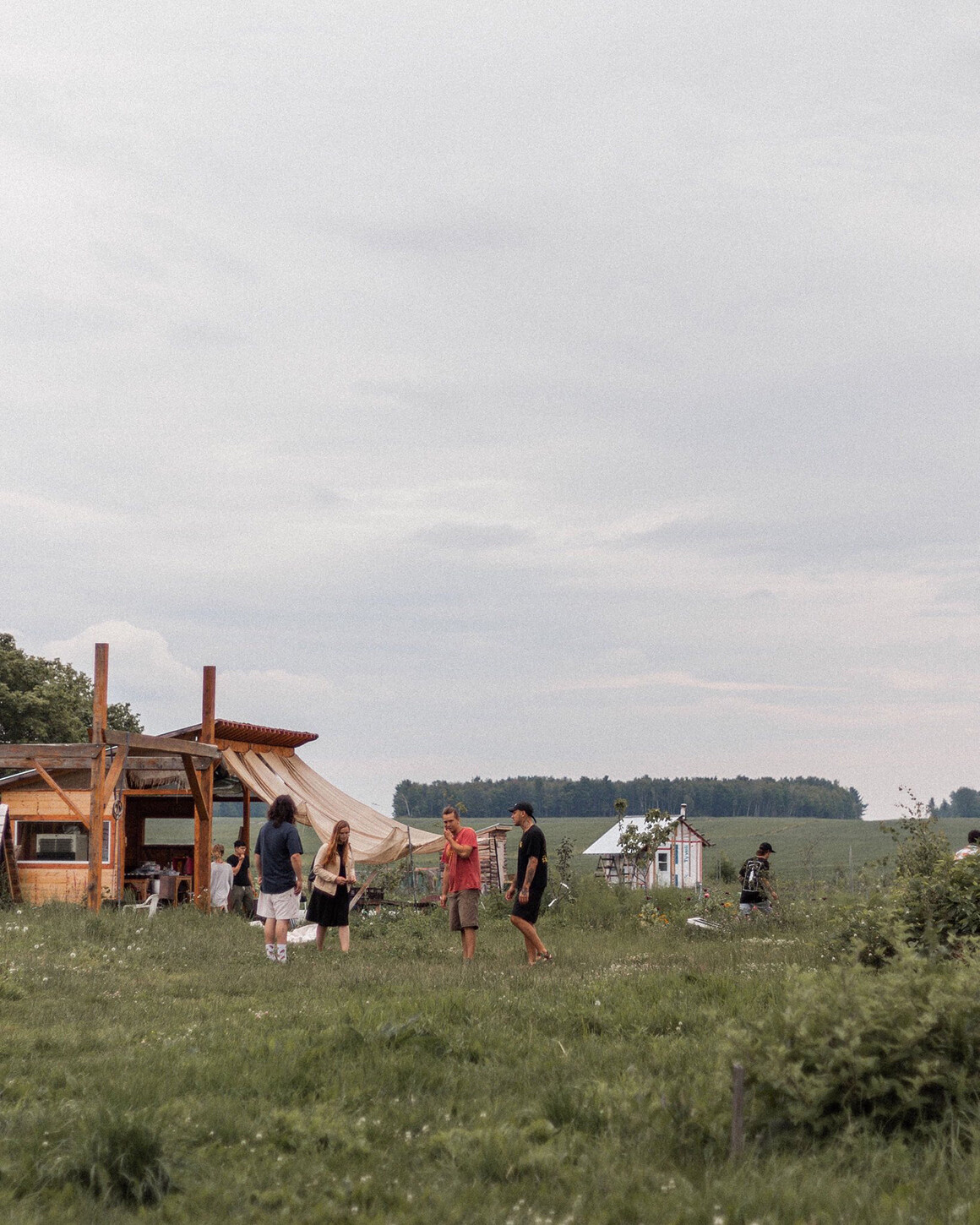

Photograph: Salon Rouge, 2022.
Salon Rouge, So-Called Quebec
One drunken autumn evening, a comrade returning to Montreal called us and announced that there was a deer that had just been hit on the road. What did he want us to do with a dead animal that was probably rotting? “Come and get it,” he told us. “We’ll prepare it. It’s in perfect condition.”
Despite our infrastructural advances towards autonomy, and although our communal farm manages to feed us more and more every year, we do not forget the ruins that surround us as well as the possibilities that are contained within them. Like a gift from the heavens, the ruins open their treasures to those who know how to find the melody in their din. We’d all gone dumpster diving before as part of our urban lives, but now we were ready to redefine what “useful” could mean. Half an hour later, the deer, dead from a concussion following a collision with a car, was spread out between the trunk and the back seats of an old Honda Civic. It would soon find itself on an outside table in front of a dozen neophytes confronted with their own ignorance. The beast said: “You don’t know anything about me.” It was true. None of us had ever set out on such a task.
Nothing was wasted: the skin was used for decoration, the meat was consumed by the whole commune over a period of several weeks, sometimes in large dinners where people congratulated themselves for having reached “new levels of dumpster diving.” Some vegans who would normally be disgusted by meat coming from industrial production were even seen eating deer in the face of what they considered to be an ethical, almost immaculate form of consumption. After being hit by a car, this beast was destined for the dump or, at best, an animal-fat processing plant. Instead, she educated us on a set of vital techniques for feeding ourselves autonomously.
Eating is an activity from which we become alienated more and more every day. Its character as a “social activity” seems to be crumbling, as shown by the image of the confined person during Covid who only knows how to order Uber Eats burgers to their city apartment. Meanwhile, the continued industrialization of all forms of production intoxicates us, destroying the possibility of building knowledge about what literally makes us live: what we eat, how we eat it, the knowledge of how to produce a vegetable, and preparation techniques. All of this vanishes into the machinery of the food industry. The techno-capitalist dream of Soylent appears as the limits of possible future horizons.
In his book America, Baudrillard spoke of a “certain solitude that resembles no other.” It was that of “the man who publicly prepares his meal, on a wall, on the hood of a car, along a fence, alone.” Calling this the “saddest thing in the world,” he wrote that there was “nothing more contradictory with the human or bestial laws, because the beasts always do each other the honor of sharing or competing for food.”4 To our minds, Baudrillard was right. The big pot containing food that is prepared and consumed collectively, the festive gatherings that allow for political conversation and conspiring, create visceral links between those with a plate. There is an elusive joy in these moments that build the commons and solidarities. In short, there is something deeply communist about food.
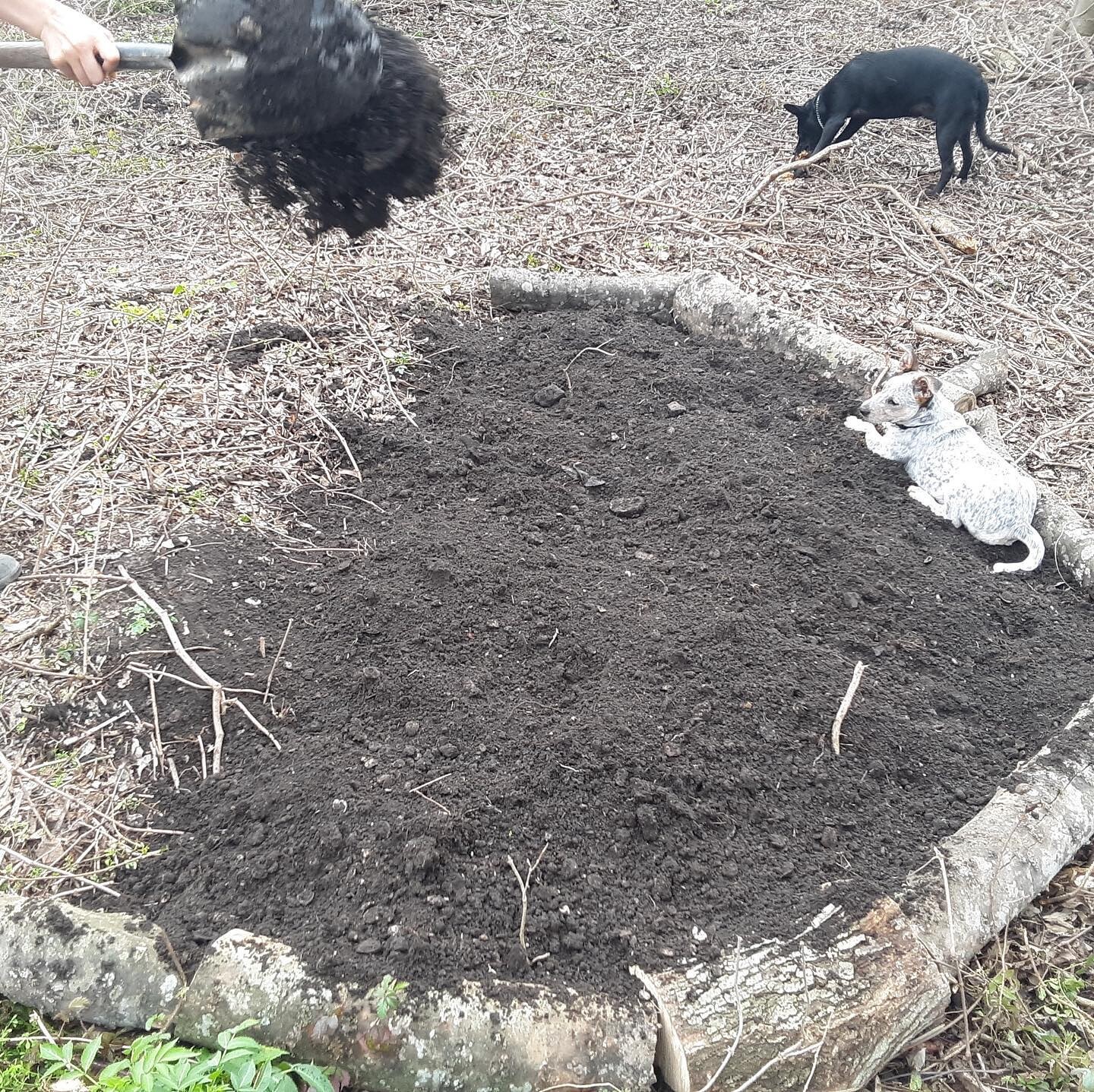

Tree crops can provide huge bounties of fruits and nuts while being much more tolerant of climate fluctuations. Planting more trees spreads tried and true carbon sequestering technology and, when done at scale, can help buffer strong winds. Uploaded to Lobelia Commons’ Instagram on January 31, 2021.
Lobelia Commons, New Orleans
Lobelia Commons formed in the specific conditions of the early Covid-19 pandemic, at a crossroads of worlds. We did not want to create a new political organization to grapple with tomorrow’s activist dilemmas. Instead, we sought to urgently make relationships through food production and semi-agricultural experimentation. The meetings of the many crises of land exploitation and climate chaos brought on by the Covid pandemic mirror the shrinking strip of land between the Mississippi River and Lake Pontchartrain here, and between the city of New Orleans and the Gulf of Mexico. The globally precarious situation is not unlike our local one.
Our dependency upon the state and its monoculture is engineered by technologies of floodwalls, levees, spillways, and river control structures. These same technologies that preserve a city in a delta seek to separate civilization from the commons, ultimately denying access entirely in what has become an existential struggle for the swamps. While some maintain piecemeal relationships with these places beyond, most of us are left expecting ships, trains, and trucks to bring food from across the world. To imagine a world beyond that monoculture, we must practice new ways of relating to agriculture, the land, and food itself.
Through conversation over coffee in a friend’s garden, chatting in Signal groups, in book clubs, with neighbors, smoking too much weed alone, we come upon our best—and worst—“what ifs.” What if we made easily reproducible mobile okra planters? What if we promoted the hell out of the idea of putting free plants in front of people’s homes? Maybe we could start growing pumpkins in that lot down the street? What if we threw Malabar spinach seeds in the bushes in front of Airbnbs? How about propagating hundreds of fruit and nut trees to give away for free? Any one of these ideas is informed by a desire for a decolonial future as well as by knowledges of survival that precede and defy New Orleans. We claim no ownership but simply seek to pass along what has inspired us.
This spirit brought us to editing and producing the Earthbound Farmer’s Almanac.5 We hoped to proliferate these types of conversations. Not that we assumed they weren’t happening—we knew they were. We just wanted them to happen even more commonly between even more people. The Almanac publishes thought and practices that could be described as anti-colonial, earthbound, autonomist, queer, and anarchist. But beyond ideological labels, we could describe it as “being in favor of the creative conditions which promote life.” We print thousands, distribute widely, cheaply, for recipients to use however they see fit. We hope they spark interesting dialogues and maybe even more interesting friendships
We believe that at the juncture of climate chaos and histories of fugitivity lie new forms of life that transcend politics. As the tides rise, our new agricultures emerge.
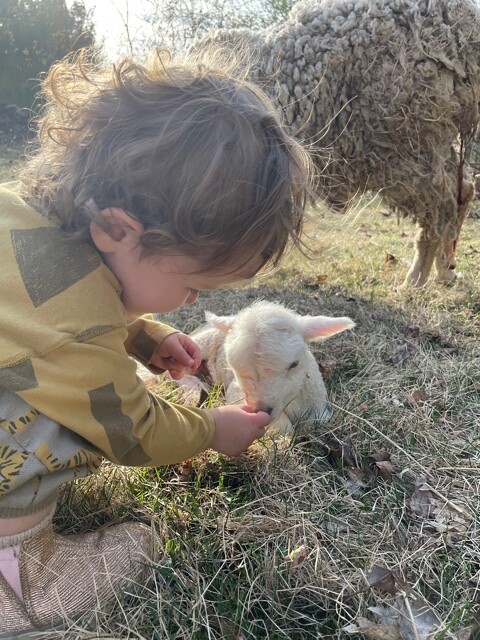

Photo courtesy of Jessica Green, 2022.
Jessica Green, Foothills of the Green Mountains
This contribution is a brief honoring of the beings to whom I am indebted. There are few identities I am willing to claim, but one I feel quite sure about is shepherdess. I tend sheep primarily for wool, which I use to weave cloth. I have lived alongside sheep for over a decade, and the mythologies and lessons I could recount are as endless as the accumulation of days we’ve been a flock together.
The wool of an animal is a tangible record of real time, of seasons, of when the rain came and when it didn’t, of time apart, of the mineral content of soil, of birth and strength and loss. The makeup of their wool holds the contents and contexts of each year that it was grown. Once they are shorn, our collaboration continues in a different manner with the spinning and dyeing and weaving of the wool. My seasons and my experiences are then embedded as the wool becomes cloth.
I also slaughter, butcher, eat my sheep, and tan their pelts. As if the gift of their being isn’t enough, I also experience their immense gift in not-being: the gift of giving an animal a dignified death and sharing the bounty of all the time that they spent as breathing bones and frolicking fat, as bleeding flesh and soft, ever-growing, delicious wool, as creatures who magically metabolize sun-drenched pastures into meat.
As days ramble on, I appreciate the years or the moments when my time and the sheep’s time feel closer together: when what we notice, record, and desire feel part of the same story, when I feel close to the hills that claim us. I wonder why it feels more wholesome and even more beautiful when my human story feels more animal, but it does. The sheep help tether me to the earth and my true nature, and I try to tend to them with respect to their sheep-ness, to honor the beings that they are—even as I continually intervene for the convenience of my humanness.
I’ve experienced the sheep’s ability to hold what I cannot—they feed the land just by being.
The South River Forest is a perfect example of a feral ecology, where nonhuman entities are tangled up with human infrastructure projects. During the night, Intrenchment Creek breaks out in a chorus of frogs hitting different pitches to build strange chords, and the turtles grow huge despite the terrible runoff from an adjacent landfill and the Atlanta Police Department firing range, which surely the deer must know to avoid by now. But the biodiversity of the forest goes beyond just those animals who live there, and includes many different people who have formed relationships with it, whether they come to forage, explore the ruins and tag the walls, walk their dogs, ride dirtbikes or ATVs or mountain bikes, find quiet among the pines, or throw a party or have a bonfire.
There is likely to be evidence of such crimes, including the graves of an unknown number of inmates who died of abuse, intentional neglect, and outright murder by guards. See Atlanta Community Press Collective, “A Brief History of the Atlanta City Prison Farm,” August 14, 2021 →.
Jean Baudrillard, America (1988; Verso, 2010).
The 2021 and 2022 editions of the Earthbound Farmer’s Almanac are available from Emergent Goods →.